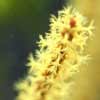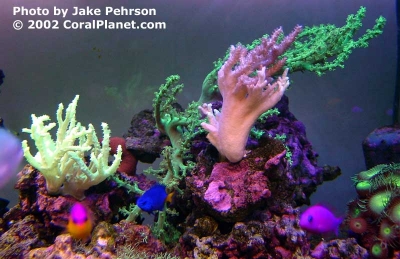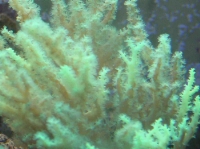| Author |
 Topic Search Topic Search  Topic Options Topic Options
|
Weimers 
Guest


Joined: January 01 2004
Location: United States
Status: Offline
Points: 2080
|
 Post Options Post Options
 Thanks(0) Thanks(0)
 Quote Quote  Reply Reply
 Topic: Nephthea Information Topic: Nephthea Information
Posted: April 10 2004 at 6:13pm |
Carl suggested that we start doing a Coral of the Week, with information to help us out. The following information should be helpful to anyone with Nephthea, and I hope it will encourage discussion. I found the following information on GENUS Nephthea in Eric Bourneman's Aquarium Corals, Selection, Husbandry, and Natural History written 2001 pp. 142-3.
Common species: N. brasilica, N. chabrolli, N. cornuta, and others.
Common names: tree coral, cauliflower soft coral.
Identification: Nephthia form upright bushy and treelike formations that are generally more squat than Litophyton. They are monomorphic, with only nonretractile autozooid polyps. Robust sclerites are mainly present in the polyps, not in the main stalks. The few sclerites in the stalk are very near the surface. When contracted, the corals adopt a cauliflower-like appearance.
Natural Location: Commonly found in reef zones that receive surge, back-reef slopes, and occasionally reef crests. Stronger flow conditions and exposure to deeper clear oceanic water are preferred. They are found in the largest sizes and greatest abundance on steep slopes at mid depths.
Colors: Usually dull cream to brown-colored, although there are occasionally brighter-colored specimens available. One of the most common Nepthea in the trade is called the "neon green tree" coral (species unknown). It normally turns brown under intense lighting, indicating the presence of zooxanthellae.
Captive Care: Nephthea are notoriously delicate to ship and have a fairly poor record of survival in the aquarium. Feeding is reported to be imperative in these corals: small particulate foods should be regularly blown across their extended polyps.
Current flow: Moderate to strong, though not so strong as to displace the unsupportive stalk.
Special info: Nephthea are one of the more toxic genera of soft corals in terms of their chemical defenses, producing some of the most diverse and unusual compounds of all soft corals. Some, such as N. brasilica are able to move their colonies in the same way as Xenia in order to colonize new areas.
Collection Impact: Widespread, common, and abundant in nature, natural populations are not likely to be diminished by collection for the aquarium trade.
Edited by Weimers
|
|
Renee and Damon Weimer
Tankless in Hawaii
|
 |
Meeshi_ma 
Guest


Joined: January 16 2004
Location: United States
Status: Offline
Points: 159
|
 Post Options Post Options
 Thanks(0) Thanks(0)
 Quote Quote  Reply Reply
 Posted: April 10 2004 at 6:16pm Posted: April 10 2004 at 6:16pm |
well, I guess its not extinct then.
|
|
Provo, Utah
|
 |
Mark Peterson 
Paid Member


Joined: June 19 2002
Location: Murray
Status: Offline
Points: 21436
|
 Post Options Post Options
 Thanks(0) Thanks(0)
 Quote Quote  Reply Reply
 Posted: April 10 2004 at 9:19pm Posted: April 10 2004 at 9:19pm |
 The few sclerites in the stalk are very near the surface. When contracted, the corals adopt a cauliflower-like appearance. The few sclerites in the stalk are very near the surface. When contracted, the corals adopt a cauliflower-like appearance. |
Not our Green Nepthea
 One of the most common Nepthea in the trade is called the "neon green tree" coral (species unknown). It normally turns brown under intense lighting, indicating the presence of zooxanthellae. One of the most common Nepthea in the trade is called the "neon green tree" coral (species unknown). It normally turns brown under intense lighting, indicating the presence of zooxanthellae. |
Not our GN. It keeps and even sometimes enhances its green zooxanthellae.
 notoriously delicate to ship and have a fairly poor record of survival in the aquarium. notoriously delicate to ship and have a fairly poor record of survival in the aquarium. |
Not our GN
 Feeding is reported to be imperative in these corals: small particulate foods should be regularly blown across their extended polyps. Feeding is reported to be imperative in these corals: small particulate foods should be regularly blown across their extended polyps. |
Not our GN
 Moderate to strong current flow, though not so strong as to displace the unsupportive stalk. Moderate to strong current flow, though not so strong as to displace the unsupportive stalk. |
Our GN likes low to moderate flow
 one of the more toxic one of the more toxic |
Not our Green Nepthia
 natural populations are not likely to be diminished by collection for the aquarium trade. natural populations are not likely to be diminished by collection for the aquarium trade. |
But we haven't seen this one brought in by the trade since the first one hit our tanks back in 1996.
What this says to me is that ours isn't your typical Nepthea. 
|
Reefkeeping Tips, & quick, easy setup tricks:www.utahreefs.com/forum/forum_posts.asp?TID=9244 Pay it forward - become a paid WMAS member 
|
 |
ssilcox 
Guest


Joined: November 17 2003
Location: Sandy
Status: Offline
Points: 3428
|
 Post Options Post Options
 Thanks(0) Thanks(0)
 Quote Quote  Reply Reply
 Posted: April 10 2004 at 9:20pm Posted: April 10 2004 at 9:20pm |
 Weimers wrote: Weimers wrote:
It normally turns brown under intense lighting, indicating the presence of zooxanthellae.
|
So this brings up a question that I have thought about - does intense lighting bring out the color in coral that host zooxanthellae or does it turn them brown? I have read that the more light the zooxanthellae have the more they fluoresce, hence brighter color from more intense light.
|
 |
Mark Peterson 
Paid Member


Joined: June 19 2002
Location: Murray
Status: Offline
Points: 21436
|
 Post Options Post Options
 Thanks(0) Thanks(0)
 Quote Quote  Reply Reply
 Posted: April 10 2004 at 10:15pm Posted: April 10 2004 at 10:15pm |
My first thought on that question is that it depends on the type/color of zooxanthellae and the color of the intense light.
VHO lighting is much superior for overall color enhancement of a wider range of coral than any other lighting system yet devised.
And sometimes conditions are not conducive to a particular zooxanthellae algae and the coral replaces it with another! For example: Red Mushrooms are notorious for "bullying" other mushrooms until everyone in the tank is red! 
I've also seen it go the other more desirable way where a nice color like the green zooxanthellae of our GN gets partially infused into neighboring coral! 
My 2 cents
|
Reefkeeping Tips, & quick, easy setup tricks:www.utahreefs.com/forum/forum_posts.asp?TID=9244 Pay it forward - become a paid WMAS member 
|
 |
Adam Blundell 
Presidency


Joined: June 24 2002
Location: Davis County
Status: Offline
Points: 18526
|
 Post Options Post Options
 Thanks(0) Thanks(0)
 Quote Quote  Reply Reply
 Posted: April 11 2004 at 9:15am Posted: April 11 2004 at 9:15am |
 Mark Peterson wrote: Mark Peterson wrote:
My first thought on that question is that it depends on the type/color of zooxanthellae and the color of the intense light. |
I agree
 Mark Peterson wrote: Mark Peterson wrote:
VHO lighting is much superior for overall color enhancement of a wider range of coral than any other lighting system yet devised. |
I disagree. I'm not that impressed with VHO light.
 Mark Peterson wrote: Mark Peterson wrote:
And sometimes conditions are not conducive to a particular zooxanthellae algae and the coral replaces it with another! |
Definately.
 Mark Peterson wrote: Mark Peterson wrote:
For example: Red Mushrooms are notorious for "bullying" other mushrooms until everyone in the tank is red!  |
I don't think they bully anything, the other mushrooms selectively collect the zooxanthellae the will best benefit them.
 Mark Peterson wrote: Mark Peterson wrote:
I've also seen it go the other more desirable way where a nice color like the green zooxanthellae of our GN gets partially infused into neighboring coral! 
My 2 cents |
Once again, the other coral choses to have that zooxanthellae. Maybe because it is more beneficial, or maybe because it is more abundant, but it captures it either way.
Adam
|
|
Come to a meeting, they’re fun!
|
 |
ssilcox 
Guest


Joined: November 17 2003
Location: Sandy
Status: Offline
Points: 3428
|
 Post Options Post Options
 Thanks(0) Thanks(0)
 Quote Quote  Reply Reply
 Posted: April 11 2004 at 9:16am Posted: April 11 2004 at 9:16am |
|
Cool - thanks for the info Mark!
|
 |
Jake Pehrson 
Admin Group


Joined: June 13 2002
Location: Murray, UT
Status: Offline
Points: 4279
|
 Post Options Post Options
 Thanks(0) Thanks(0)
 Quote Quote  Reply Reply
 Posted: April 12 2004 at 8:51am Posted: April 12 2004 at 8:51am |
 Mark Peterson wrote: Mark Peterson wrote:
 The few sclerites in the stalk are very near the surface. When contracted, the corals adopt a cauliflower-like appearance. The few sclerites in the stalk are very near the surface. When contracted, the corals adopt a cauliflower-like appearance. |
Not our Green Nepthea .....
What this says to me is that ours isn't your typical Nepthea.  |
What this tells me is that this is not Nephthea. Probably Sinularia.
 Adam Blundell wrote: Adam Blundell wrote:
 Mark Peterson wrote: Mark Peterson wrote:
My first thought on that question is that it depends on the type/color of zooxanthellae and the color of the intense light. |
I agree
|
I think most experts now agree that zooxanthellae is brown. The colors (other then brown) that we see are skin pigments (although I'm not sure I am convinced of this).
Edited by Jake Pehrson
|
|
|
 |
sjlopez39 
Guest


Joined: January 18 2003
Location: United States
Status: Offline
Points: 479
|
 Post Options Post Options
 Thanks(0) Thanks(0)
 Quote Quote  Reply Reply
 Posted: April 12 2004 at 9:00am Posted: April 12 2004 at 9:00am |
|
Will the "real" Green Nepthia please stand up?
|
|
Keep your hands and arms inside the tank and enjoy the ride!
Steve
|
 |
Weimers 
Guest


Joined: January 01 2004
Location: United States
Status: Offline
Points: 2080
|
 Post Options Post Options
 Thanks(0) Thanks(0)
 Quote Quote  Reply Reply
 Posted: April 12 2004 at 4:48pm Posted: April 12 2004 at 4:48pm |
|
Okay, I spent a bunch of time typing this out very carefully so that I was quoting Eric Borneman properly. So how do we figure out if what we call green nepthia belongs to this genus? Do I re-post it to Reef Central and hope that Mr. Borneman will review it in his official capacity?
|
|
Renee and Damon Weimer
Tankless in Hawaii
|
 |
Jake Pehrson 
Admin Group


Joined: June 13 2002
Location: Murray, UT
Status: Offline
Points: 4279
|
 Post Options Post Options
 Thanks(0) Thanks(0)
 Quote Quote  Reply Reply
 Posted: April 12 2004 at 6:15pm Posted: April 12 2004 at 6:15pm |
Just an observation.
How fast we mutate from the Nephthea to Nepthea to Nepthia.
Also the "Green Tree Nephthea" that we pass around does turn more brown the brighter the lights are (at least in my observation). The lower lighted tanks seem to produce brighter greens.
Edited by Jake Pehrson
|
|
|
 |
Mark Peterson 
Paid Member


Joined: June 19 2002
Location: Murray
Status: Offline
Points: 21436
|
 Post Options Post Options
 Thanks(0) Thanks(0)
 Quote Quote  Reply Reply
 Posted: April 12 2004 at 10:44pm Posted: April 12 2004 at 10:44pm |
 Jake Pehrson wrote: Jake Pehrson wrote:
The lower lighted tanks seem to produce brighter greens. |
I'm not sure about that. The pic you took a couple years ago of GN/Sinularia/or whatever it is, from the Bangerter tank is the greenest ever. Compare that to the faded green of the same coral in Oboy's NO lighted tank and Seti007's MH lighted tank.
VHO: 
MH:  NO: 
|
Reefkeeping Tips, & quick, easy setup tricks:www.utahreefs.com/forum/forum_posts.asp?TID=9244 Pay it forward - become a paid WMAS member 
|
 |
Adam Blundell 
Presidency


Joined: June 24 2002
Location: Davis County
Status: Offline
Points: 18526
|
 Post Options Post Options
 Thanks(0) Thanks(0)
 Quote Quote  Reply Reply
 Posted: April 13 2004 at 8:08am Posted: April 13 2004 at 8:08am |
Mark,
Read Jake's quote again. I think you said you disagree with him, but then you agreed with your pics. The Bangerter tank has the greenest coral (what you said) yet it does have LOWER lighting than Asad's MH.
This, along with some other junk, has always made me wonder why people want there corals to be nice and bright with lots of color.... maybe that isn't natural. Another one of those "Adam Cringe" subjects so I'll go back to being quiet on this topic.
Adam
|
|
Come to a meeting, they’re fun!
|
 |
Mark Peterson 
Paid Member


Joined: June 19 2002
Location: Murray
Status: Offline
Points: 21436
|
 Post Options Post Options
 Thanks(0) Thanks(0)
 Quote Quote  Reply Reply
 Posted: April 13 2004 at 8:19am Posted: April 13 2004 at 8:19am |
What I was thinking was that the pics showed that the lowest light didn't seem to bring out the brightest green but perhaps, rather it is the type of light. 
|
Reefkeeping Tips, & quick, easy setup tricks:www.utahreefs.com/forum/forum_posts.asp?TID=9244 Pay it forward - become a paid WMAS member 
|
 |
jfinch 
Guest


Joined: March 06 2003
Location: Pleasant Grove
Status: Offline
Points: 7067
|
 Post Options Post Options
 Thanks(0) Thanks(0)
 Quote Quote  Reply Reply
 Posted: April 13 2004 at 8:27am Posted: April 13 2004 at 8:27am |
|
The intensity of the green color has more to do with actinics then anything else, imo. Without a lot of actinic light it's a bit on the drab side. With lots of actinic it's like a neon sign.
|
|
|
 |
Weimers 
Guest


Joined: January 01 2004
Location: United States
Status: Offline
Points: 2080
|
 Post Options Post Options
 Thanks(0) Thanks(0)
 Quote Quote  Reply Reply
 Posted: April 13 2004 at 10:05am Posted: April 13 2004 at 10:05am |
I got my GN from OBoy about 3 weeks ago. It was a uniform light green color at the time. Since then, it seems to have more brown in the tips. We've got aquaspace lights approx. 30" from the top of the GN frag. We run the actinics approx 9 hrs a day. It definitely glows when we have just the actinics lit. I'm glad that we're discussing this - I was afraid I typed for an hour & a half for nothing.
Renee
|
|
Renee and Damon Weimer
Tankless in Hawaii
|
 |
Mark Peterson 
Paid Member


Joined: June 19 2002
Location: Murray
Status: Offline
Points: 21436
|
 Post Options Post Options
 Thanks(0) Thanks(0)
 Quote Quote  Reply Reply
 Posted: April 13 2004 at 11:53am Posted: April 13 2004 at 11:53am |
All that writing to get our degrees must have been good for something, even if it's just More of the Same BS 
For what it's worth, I never was certain that the fluorescent green came from algae. Seems that there is some info somewhere on fluorescence in coral and what causes it, something about the absorption of light energy and re-emitting it at a slightly different wave length. Actually sounds fascinating for a  like me.
|
Reefkeeping Tips, & quick, easy setup tricks:www.utahreefs.com/forum/forum_posts.asp?TID=9244 Pay it forward - become a paid WMAS member 
|
 |
Weimers 
Guest


Joined: January 01 2004
Location: United States
Status: Offline
Points: 2080
|
 Post Options Post Options
 Thanks(0) Thanks(0)
 Quote Quote  Reply Reply
 Posted: April 13 2004 at 5:32pm Posted: April 13 2004 at 5:32pm |
|
Did you get an M.S. in B.S. as well? I thought it was a special program they built just for me! Actually, now I wish I had a Masters in Biology or Marine Biology. Instead of the M. of Human Relations. I find that some people really freak me out - like my neighbor, whose dog just bit P.C. Pondbuilder's assistant. And now the neighbors seem to think that I should pay the $270 for their dog being in quarantine. So d'ya think I could pursue a PhD in Biology or Marine Biology? Serious question. But you can laugh if you'd like!! Totally allowed.
|
|
Renee and Damon Weimer
Tankless in Hawaii
|
 |
Adam Blundell 
Presidency


Joined: June 24 2002
Location: Davis County
Status: Offline
Points: 18526
|
 Post Options Post Options
 Thanks(0) Thanks(0)
 Quote Quote  Reply Reply
 Posted: April 13 2004 at 5:50pm Posted: April 13 2004 at 5:50pm |
 Weimers wrote: Weimers wrote:
So d'ya think I could pursue a PhD in Biology or Marine Biology? Serious question. But you can laugh if you'd like!! Totally allowed. |
I can safely say that you don't want to do that. You could turn out like me, and you don't want that.
Adam
|
|
Come to a meeting, they’re fun!
|
 |
Weimers 
Guest


Joined: January 01 2004
Location: United States
Status: Offline
Points: 2080
|
 Post Options Post Options
 Thanks(0) Thanks(0)
 Quote Quote  Reply Reply
 Posted: April 13 2004 at 6:35pm Posted: April 13 2004 at 6:35pm |
|
Actually, I wouldn't mind "turning out" like you. I've been looking for a PhD in Adult Learning or something that does research in the multi-media (web-based, etc.) arena. Can't find what I'm looking for in the education area, so maybe go back to an old dream of mine. Did I tell you that I did want to be a Marine Biologist? I ended up being a Marine. "ooh - RAH!" Well, it paid for college!!
|
|
Renee and Damon Weimer
Tankless in Hawaii
|
 |